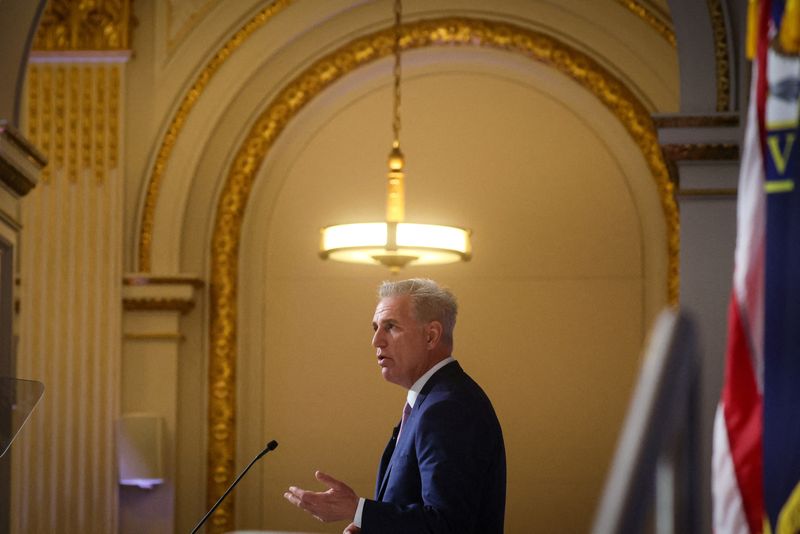By Andy Sullivan
WASHINGTON (Reuters) – The spending-cut proposals unveiled by U.S. House of Representatives Speaker Kevin McCarthy on Monday could fall hardest on people in Republican-leaning states, a Reuters analysis of federal spending data found.
McCarthy’s plan, which he presented as a condition for raising the United States’s $31.4 trillion debt ceiling, calls for cutting some agency budgets by 7% this year and capping their growth by 1% annually after that.
It also would impose stiffer work requirements on some benefit programs, which could reduce the number of people who receive them.
McCarthy only laid out broad contours on Monday, rather than unveiling finished legislation, which makes it difficult to determine the proposed cuts’ precise toll.
But a Reuters analysis of federal spending data indicates that his proposed domestic-spending caps could be felt most acutely in the states that backed Republican President Donald Trump in the 2020 presidential election.
Those 25 states received roughly $172 billion in the last fiscal year for highway construction, housing, public health and other purposes, amounting to $1,196 per person.
The 25 states plus the District of Columbia that backed Democrat Joe Biden received $205 billion, or $1,079 per person.
The amounts involved were smaller in 2019, before the federal government approved trillions of dollars in COVID-19 aid, but the pattern was the same: $411 per person in Trump states, compared to $360 per person in Biden states.
The amounts vary dramatically from state to state. In the 2022 fiscal year, heavily Democratic California received $760 per capita, while deeply Republican Alaska got $6,423 per resident.
POVERTY AND TAXES
Much of that money is distributed through formulas that take factors like poverty into account. As a result, federal aid does not play as big a role in relatively wealthy, Democratic-leaning states like New Jersey that are more able to raise their own taxes to fund safety-net programs, said Marcia Howard, executive director of Federal Funds Information for States.
“As a rule, wealthier states get fewer funds per capita,” she said.
McCarthy’s proposed increase of 1% per year would not keep up with inflation or population growth. Those caps could be felt most acutely in Trump-voting states, where the collective population grew 9.8% between 2010 and 2022, nearly twice the 5.3% growth rate in Biden states.
SOCIAL SECURITY AND DEFENSE
McCarthy’s spending cuts would not scale back Social Security retirement benefits, which are projected to double in cost over the coming 10 years.
But the agency warned last month that budget cuts could make it more difficult to administer benefits. That could have a bigger impact in Trump-voting states, where 20.1% of residents rely on the program, compared to 18.6% of residents in Biden states.
It is not clear whether McCarthy’s caps would apply just to domestic programs, as some media outlets have reported, or would cover military and veterans programs as well. His office did respond to a request for clarification.
WORK REQUIREMENTS
McCarthy also proposed stiffening work requirements for benefit programs like SNAP, which provides grocery money for low-income people.
That, likewise could hit Republican-leaning states harder: 3.1% of the population in those states could lose benefits, compared with 2.8% of residents in Biden states, according to a Reuters analysis of data compiled by the Center for Budget and Policy Priorities, a left-leaning think tank.
Republicans have tried for years to tighten these programs to lower costs and push more people into the work force.
But spending cuts could undercut that goal.
In Calcasieu Parish, Louisiana, several dozen SNAP participants rely on a separate federal program to help cover child-care and transportation costs to get to work, said Terek Polite, who oversees the program for the local government. Any cuts could force those people to quit their jobs, he said, adding, “As opposed to scrapping the program, maybe they need to strengthen it.”
(Reporting by Andy Sullivan; Editing by Scott Malone and Alistair Bell)

